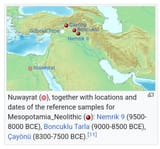>>514161781
>This Skhirat-Rouazi (SKH) population is the one which forms the bulk (~77.6%) of the ancestry of the Egyptian Old Kingdom individual from Nuwayrat NUE001
>The remaining ~22% of the Nuwayrat individual's genetic ancestry derived from Neolithic Mesopotamian-related populations, likely originating from the eastern Fertile Crescent, including Mesopotamia. The referenced "Mesopotamia_Neolithic" cluster consisted in a dozen samples from Nemrik 9 (9500-8000 BCE), Boncuklu Tarla (9000-8500 BCE) and Çayönü (8300-7500 BCE), all Pre-Pottery Neolithic cultures (Pre-Pottery Neolithic A or Pre-Pottery Neolithic B) located in Upper Mesopotamia and Central Mesopotamia. These sites, such as Çayönü or Boncuklu Tarla, developed from the Taş Tepeler cultural tradition of Gobekli Tepe, and a site such as Çayönü is where some of the first animal domestication occurred (the pig may have first been domesticated there in 8,500 BCE) and agriculture developed from the 9th millenium BCE
>In a 2022 genetic study, the population of Çayönü (8300-7500 BCE) was analyzed as a representative of the earliest known hunter-gatherer sedentary populations who built the monumental structure of Gobekli Tepe and domesticated various plants and animals, such as the einkorn, emmer, sheep, goats, pigs and cattles in Upper Mesopotamian. The Çayönü population was shown to be genetically diverse, carrying both western and eastern Fertile Crescent ancesty, and best modelled by an ancestry combining about 48% Anatolian Epipaleolithic, 33% Central Zagros Neolithic and 19% South Levant Neolithic components
